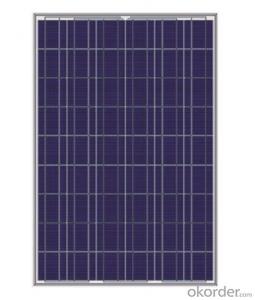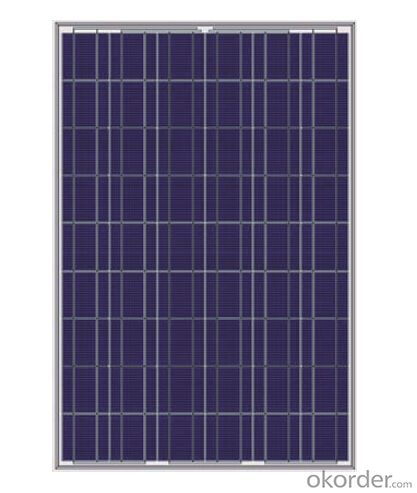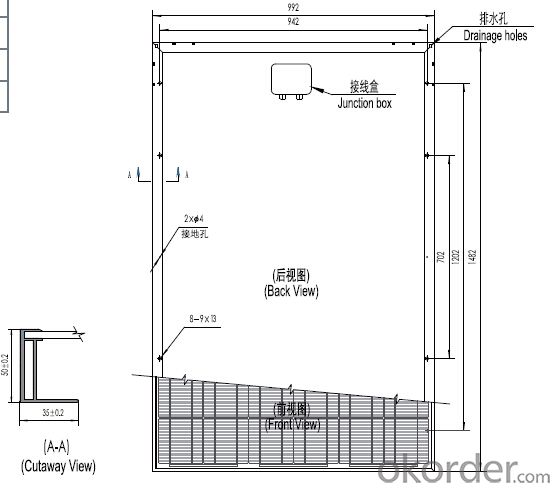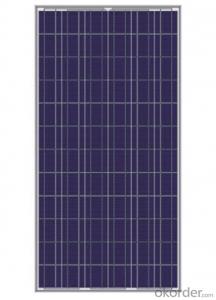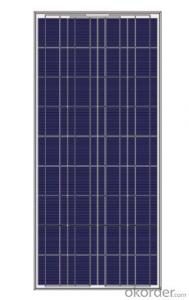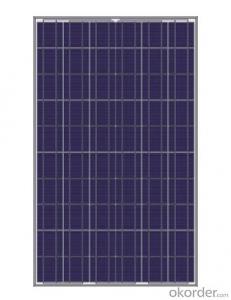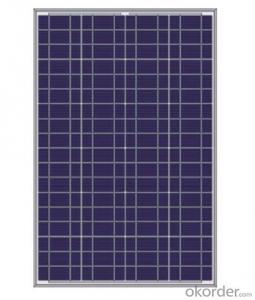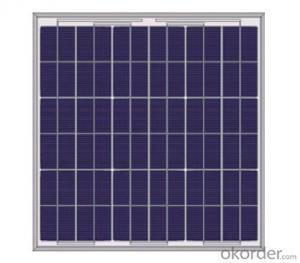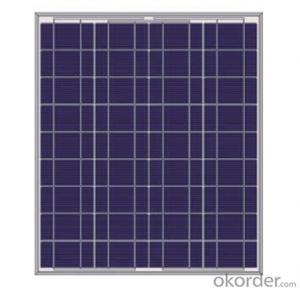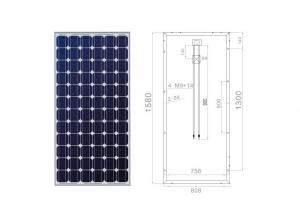Miami Solar Panels - Polycrystalline Silicon Solar Panel (CR210P-CR180P)
OKorder Service Pledge
OKorder Financial Service
You Might Also Like
High-efficient solar cells
High transmissivity low-iron toughened glass
Anodized aluminum frame
Water resistant junction box
Design to meet unique demand of customer
25 year poweroutput warranty

the products of this series:Polycrystalline silicon solar panel(CR210P-CR180P) are ranged as follows:
CR210P,CR200P,CR190P,CR180P
of which,
cell dimension:156mm*156mm
number of celles and connections: 54(6*9)
panel dimension: 1482*992*50(mm)
per weight: 17.2KG
junction box type: QC506-1
cable and asymmetrical lengths: NANYANG(4.0mm2), 900mm(-)and 900mm(+)
connection: MC4
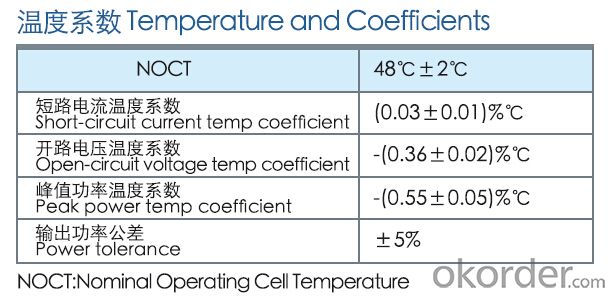

- Q: is this fact true? - its a limitation to solar panels during summer when it's in extremly hot countrie. I've heard it from my science teacher .. please give detail if you have any and any more benefits/limitations is welcomed .. Thank you :) !
- i couldn't see any evidence of that on the internet, but i only searched for a little while for ya. all i can say is in Australia 40 - 50 degrees celcious is about our hottest, and i have never heard of it being a problem. im sure that being the sunburnt country we would know as general knowledge if the solar systems didn't go well if it was too hot.
- Q: Well I was thinking about the idea of renovating either a smaller school bus or building a tiny house and I was wondering if i can get some information on the size and watts panel should I use or more like how to get that whole solar energy in motion. Any infor and links would help
- I think that typical solar panels are 2'x4' and produce something like 800-000 wh per day. (That's 0.8 - kwh per day.) More in the summer, less in the winter, if they're aimed sort of at the sun. There are newer, more expensive panels that produce more. There are also thin film panels that are less expensive, and probably more sturdy. You then have a couple choices. In a house, you'd have an expensive inverter to connect to the utility power, so you can have power at night when your panels aren't generating anything. In a trailer, you want 2-4-6 deep cycle car batteries to store the power. Then you could have an inverter to convert that power to 20v AC, so you could use normal appliances. Or, you could buy appliances that run on 2 volts DC. Maybe a combination of both. You'll need to figure out how much power you're going to use, so you know how many panels and batteries you're going to need. The calculation is easy. Figuring out how much power you need is hard. You need deep cycle batteries because you can repeatedly charge them way up and run them way down. Ordinary batteries die fairly quickly when you do that.
- Q: For a computer technology project we are using solar panels and trying to see different methods that will increase the output of solar power from these panels. For now, we have got polymer stickers and mirrors. Are there any more methods, or information that increase the solar power? Please and thank you :)
- If it's a solar heating panel, add insulation around it. If it's a solar electric panel, chill it in some manner, like with a fan, mist of water, etc. Electric panels are generally more efficient when cold.
- Q: We are considering getting solar panels for our home just south of Birmingham, AL. We know a little and are trying to educate ourselves the best we can. But we are having a hard time finding anyone around this area. We have done the yellow page thing, and some quot;green places around town. But to no luck.....
- Any electrical contractor could likely install them, and there are several Internet businesses that sell solar panels. You likely have no place there to get the kind of large panels you need for a house. Look at your local regulations. Your utility may not allow grid-tie, so you may have to set up an off-grid system with batteries and use separate wiring or a transfer switch. One thing a lot of people neglect is hail protection. In Birmingham, you're likely to have large hail (larger than golf ball size) every couple of years in the spring. You need to work out a way of covering them in advance of severe weather. Most panels will take up to golf-ball size hail with no problem. DK PS, I've done this myself, and have considerably more information. Email if you're interested.
- Q: What are the different applications for solar panels for residential use? How many should I purchase if the avg panel produces 80 watts .
- Let me start off by saying we (my family and I) live completely, 00% “off of the grid and are completely self sufficient” The house is built utilizing natures natural elements, in the shape of an octagon with 8ft wide arch doors on every wall to catch every angle of wind (typical 4 sided homes have half the chance as one with 8 sides.
- Q: Can solar panels be damaged by birds or rodents?
- Yes, solar panels can be damaged by birds or rodents. Birds may build nests or perch on the panels, which can cause blockages or scratches. Rodents such as squirrels or rats may chew on the wires or insulation, leading to malfunctions or electrical issues. It is important to take preventive measures to protect solar panels from potential damage.
- Q: What is the difference between on-grid and off-grid solar systems?
- The main difference between on-grid and off-grid solar systems is how they are connected to the power grid. On-grid solar systems are connected to the local utility grid, allowing excess electricity generated by the solar panels to be fed back into the grid and credited to the homeowner. This means that on-grid systems rely on the grid for power during times when the sun is not shining, such as at night or during cloudy days. On the other hand, off-grid solar systems are not connected to the power grid and operate independently. These systems typically use batteries to store excess electricity generated during the day for use during periods of low or no sunlight. Off-grid systems are commonly used in remote areas where connecting to the grid is not feasible or cost-effective. Overall, the distinction lies in the connection to the power grid and the reliance on it for electricity supply.
- Q: I would like a list of the solar companies expanding or doing hiring or a good list in general. I know some are expanding. Best answer gets all the points
- you won't be in a position to purchase at that point except you're related to governement. a lot of manufacturing is already spoken for for years yet to come again. the place you reside determines what you may legally purchase and installation. the ecu has this is own certification, the U. S. has 2 gadgets, the Canadians have their own. Your answer additionally demands understanding the use for the photograph voltaic panels, despite if it extremely is grid-tie, off-grid or standalone to skill an equipment. and additionally you may desire to choose for mono crystalline, poly crystalline, or skinny-action picture.
- Q: Can solar panels be used in areas with frequent lightning storms?
- Yes, solar panels can be used in areas with frequent lightning storms. However, it is recommended to take certain precautions to minimize the risk of damage. These precautions include installing surge protection devices, grounding systems, and lightning arrestors to divert the lightning strike's energy away from the solar panels. Additionally, using high-quality equipment that meets safety standards can also help mitigate potential damage caused by lightning strikes.
Send your message to us
Miami Solar Panels - Polycrystalline Silicon Solar Panel (CR210P-CR180P)
OKorder Service Pledge
OKorder Financial Service
Similar products
Hot products
Hot Searches
